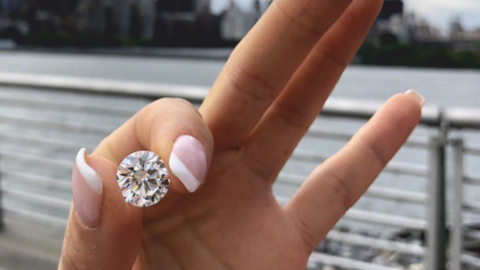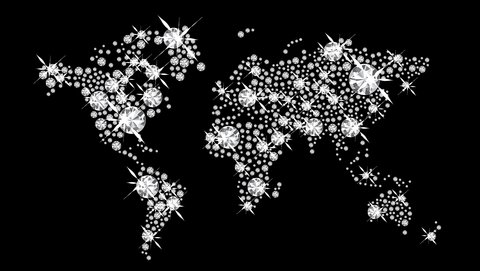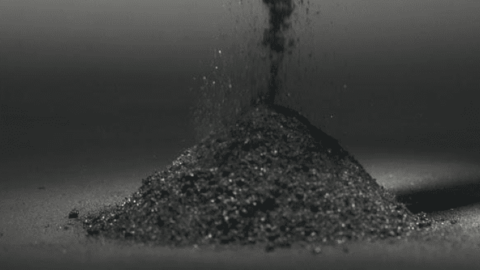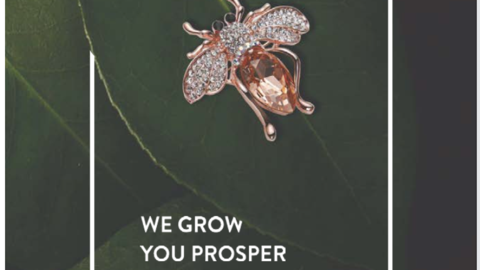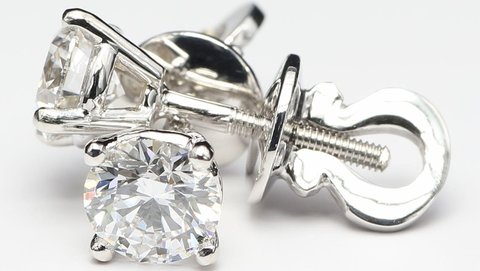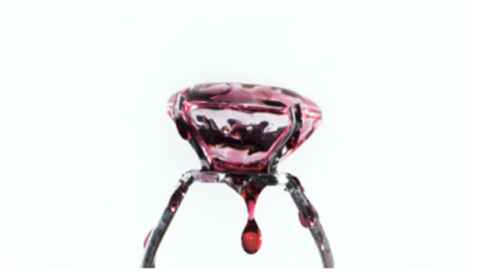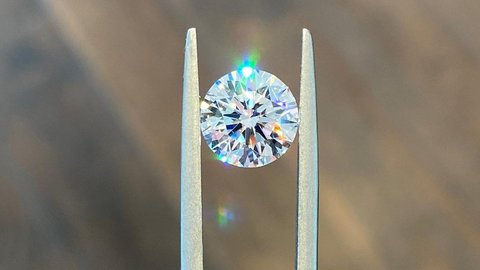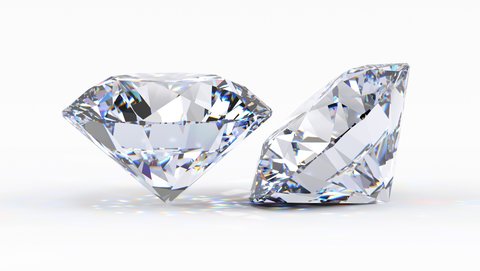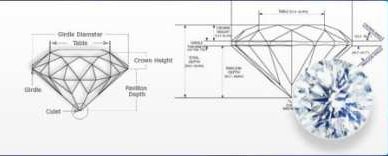Why Millennials Love Lab Grown Diamonds
Why Do Millennials Love Lab Grown Diamonds? The Complete Guide
Author: Alex K., CMO at Labrilliante Updated: 2025-10-16 Reading Time: 8 minutes
Millennials choose lab grown diamonds for their perfect combination of conscious values, superior affordability, and identical beauty to mined stones. Laboratory creation produces Type IIa purity in most gems versus under 2% in natural diamonds, while eliminating mining's 250-ton earth displacement per carat. Smart couples get larger, cleaner stones at 30-40% savings without compromising romance or durability.

Modern romance meets conscious consumerism as today's engaged couples redefine luxury through ethical choices. Lab grown diamonds represent more than just an alternative—they've become the preferred symbol for relationships built on shared values and financial wisdom. This generation refuses to compromise between stunning beauty and social responsibility, discovering that laboratory innovation delivers both without sacrifice. You'll explore the technical breakthroughs making lab diamonds superior in many measurable ways, the celebrity influence driving design trends, and practical strategies for maximizing your engagement ring investment.
Traditional Jewelers Push Back: Why Some Still Favor Mined Diamonds
The strongest argument against lab diamonds centers on long-term value retention and traditional luxury prestige. Established jewelers argue that mined diamonds hold their worth better over decades, citing current resale markets where natural stones command 15-25% higher prices than lab equivalents. Family heirloom considerations also favor traditional stones, as older generations often view laboratory creation as "artificial" despite identical chemical composition.
However, this perspective overlooks fundamental shifts in consumer priorities and market dynamics. Millennials statistically prioritize purchase value over resale potential when buying lifetime jewelry, making the resale argument less relevant to the target demographic. More importantly, as lab diamond acceptance grows and production quality consistently exceeds mined averages, market perception gaps continue narrowing—suggesting today's "value retention" concerns may prove temporary rather than permanent.
Get Celebrity Ring Style Without Breaking Bank
Millennials recreate celebrity marquise engagement rings using lab diamonds at 30-40% lower prices than mined stones. Smart money move. The east-west marquise setting sparked a revival of this vintage cut, making it the most sought-after celebrity style of 2025.
The marquise experienced a dramatic comeback after decades of obscurity. Originally commissioned by King Louis XV in the 1740s, this football-shaped cut fell out of favor during the round brilliant's dominance. Now? Celebrity influence plus lab diamond accessibility transforms marquise cuts into millennial status symbols.
| Carat Weight | Lab-Grown Marquise Diamond Price | Natural Marquise Diamond Price | Dollar Savings | Percentage Savings | Celebrity Style Comparable |
|---|---|---|---|---|---|
| 1.5 ct | $1,350 | $9,500 | $8,150 | 86% | East-West Statement Ring |
| 2.0 ct | $1,800 | $14,200 | $12,400 | 87% | Modern Celebrity Style |
| 2.5 ct | $2,625 | $18,750 | $16,125 | 86% | Instagram Influencer Look |
| 3.0 ct | $3,300 | $24,000 | $20,700 | 86% | Selena Gomez Inspired |
| 4.0 ct | $4,800 | $35,200 | $30,400 | 86% | Red Carpet Statement |
| 5.0 ct | $7,000 | $52,500 | $45,500 | 87% | A-List Celebrity Level |
| 7.0 ct | $12,250 | $91,000 | $78,750 | 87% | Ultra-Luxury Celebrity |
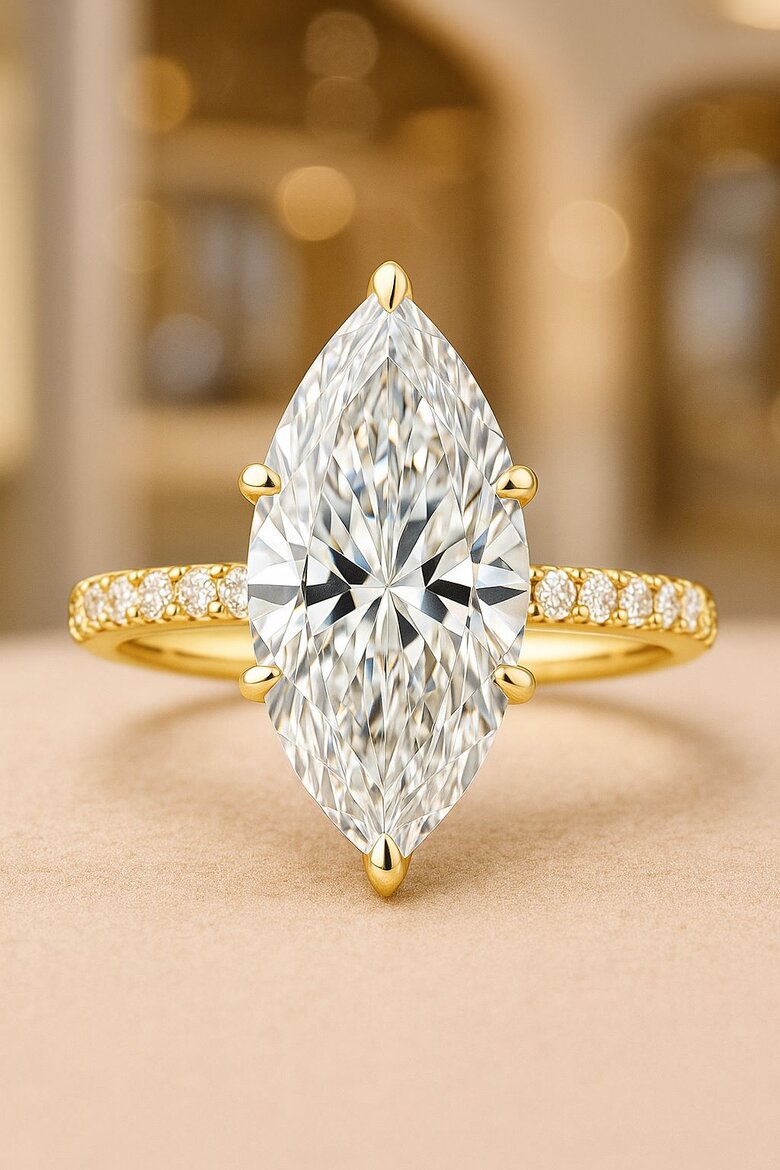
Selena Gomez Marquise Look for Less
Getting the celebrity marquise aesthetic requires precise length-to-width ratios between 1.85:1 and 2.00:1. Technical challenge solved. CVD technology excels here because controlled growth creates larger, cleaner crystals with fewer inclusions near vulnerable pointed ends.
Celebrity rings typically feature 5-10 carat weights, previously exclusive to ultra-wealthy buyers. Lab alternatives democratize this luxury while maintaining identical optical properties. The trade-off? Potential resale considerations, though millennials prioritize purchase value over future liquidation.
Marquise cuts demand specialized settings due to pointed tips. Prong placement must protect vulnerabilities while maximizing light entry. Poor alignment creates the dreaded "bow-tie effect" – a dark center zone that kills brilliance.
East West Settings Trending Celebrity Style
East-west orientation rotates diamonds 90 degrees horizontally, emphasizing finger coverage while reducing visual height. This Art Deco revival photographs better in smartphone aspect ratios. Instagram influence at work.
A 3-carat marquise set east-west visually competes with a 4-carat traditional round. Same impact, significant savings. But here's the catch: east-west settings concentrate stress differently, requiring modified mounting and potentially thicker bands for durability.
"East-west settings not only adapt the marquise cut for a modern aesthetic but also ingeniously distribute surface area to create an illusion of greater size. This orientation, while aesthetically pleasing, demands precise engineering behind the scenes. Each setting must be uniquely calibrated to ensure the diamonds structural integrity and brilliance is maintained, despite the unconventional horizontal stress distribution. Our innovative mounting techniques have been developed to enhance both the appearance and longevity of these diamonds, ensuring they meet our rigorous standards for quality and beauty."
Choose Guilt Free Luxury Diamond Romance
Lab diamonds eliminate mining ethics concerns while delivering identical beauty and durability. Millennials drive 70% of lab diamond purchases because these align with conscious values. No compromise on luxury or romance.
The diamond industry carries historical baggage: conflict financing and environmental disruption from large-scale mining. While the Kimberley Process improved oversight since 2003, consumers prefer guaranteed conflict-free origins over monitoring systems.
| Environmental Factor | Mined Diamonds (per carat) | Lab-Grown Diamonds (per carat) | Impact Reduction |
|---|---|---|---|
| Earth Moved | 250 tons | 0 tons | 100% reduction |
| Water Usage | 3,890 liters | 70 liters | 98% reduction |
| Energy Consumption | 538.5 million joules | 250 million joules | 54% reduction |
| Carbon Emissions | 125 kg CO2 | 6 kg CO2 | 95% reduction |
| Land Disruption | 98 square meters | 0 square meters | 100% reduction |
| Water Contamination Risk | High (mining chemicals) | None | 100% elimination |
| Habitat Destruction | Permanent ecosystem damage | Zero impact | 100% elimination |
| Rehabilitation Required | 25+ years post-mining | None required | 100% elimination |
Conflict Free Guarantee Lab Diamond Benefits
Laboratory creation provides absolute supply chain transparency through controlled facilities with documented energy sources and labor conditions. Zero geographical risk factors. Complete elimination of conflict financing possibilities.
Mining recovers diamonds formed billions of years ago under unpredictable geological conditions. Wide quality variations result. Laboratory growth enables precise crystal formation control, producing higher average clarity grades and fewer internal stress patterns affecting durability.
The reality check? Current resale markets value lab diamonds lower than mined equivalents. This reflects market psychology, not inherent value. Younger buyers show less concern about resale when purchasing lifetime jewelry.
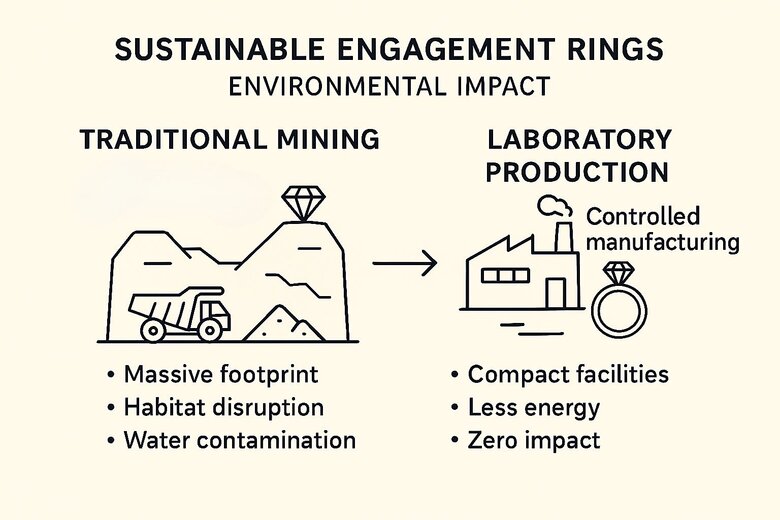
Sustainable Engagement Rings Environmental Impact
Traditional mining moves 250 tons of earth per gem-quality carat. Massive environmental footprint. Laboratory production reverses this equation through controlled manufacturing in compact facilities.
CVD operates at atmospheric pressure using methane and hydrogen gases. HPHT replicates natural formation in compact chambers. Both consume significantly less energy per carat than extraction, transportation, and processing stages for mined diamonds.
Environmental wins include zero habitat disruption, no water contamination risks, and no land rehabilitation requirements. Laboratory facilities integrate into existing infrastructure without ecosystem impact.
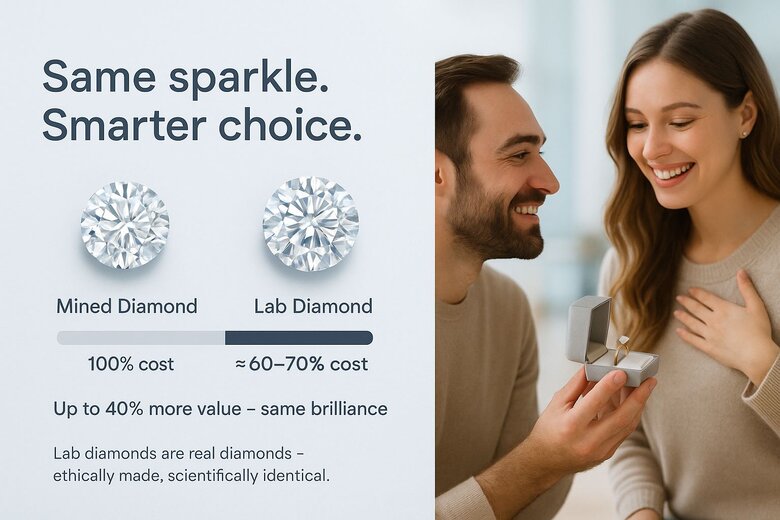
Unlock 70% Savings Smart Millennial Money Strategy
Lab diamonds cost 30-40% less than identical mined specifications, enabling larger stones within existing budgets. This reflects manufacturing efficiency, not quality compromise. Identical crystal structure and optical properties guaranteed.
The math appeals to data-driven millennial thinking. Purchase a 2-carat lab diamond for the price of a 1.2-carat mined stone. Measurably superior visual impact with identical durability characteristics. Rational value optimization wins.
Price advantages compound as production scales and efficiency improves. Mining faces increasing extraction costs as accessible deposits deplete. Long-term economics favor laboratory alternatives.
However, insurance valuations and financing may vary. Some traditional jewelers maintain higher appraisals for mined stones, though this gap narrows with growing acceptance. Millennials prioritize purchase optimization over appraisal maximization anyway.
The size question becomes rational when quality stays identical at reduced prices. A 3-carat lab diamond provides substantially greater presence than a 1.5-carat mined alternative at equivalent cost. Aesthetic preferences meet economic sensibility.
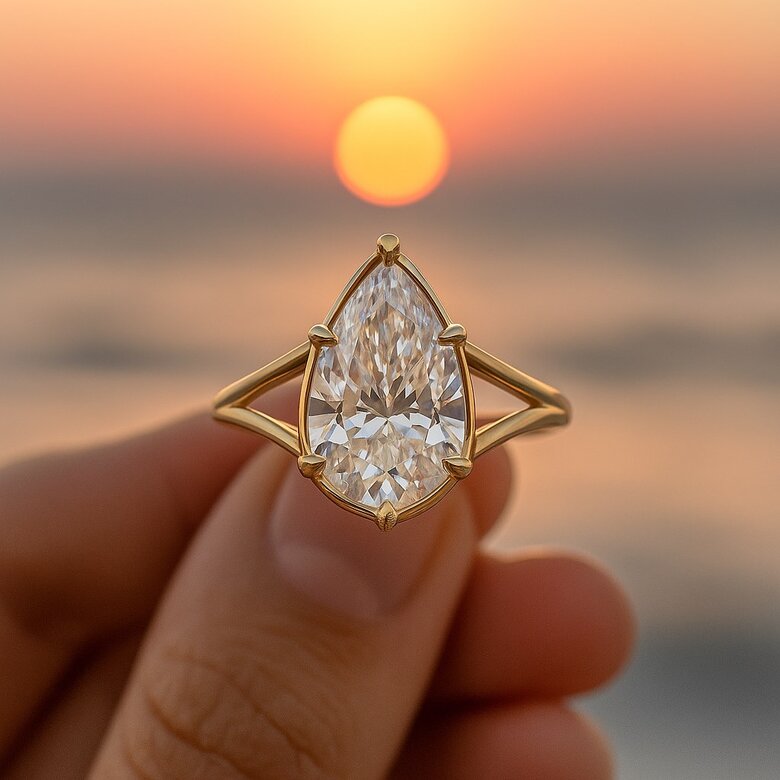
Create Instagram Worthy Proposal Ring Moments
Social media drives 60% of millennial engagement ring decisions through Instagram and Pinterest inspiration. Lab diamonds photograph identically to mined stones while enabling larger sizes for dramatic visual impact. Perfect for sharing culture.
Rings featuring 2+ carat centers generate significantly higher social engagement rates. Budget constraints traditionally limited access to this category. Lab alternatives democratize Instagram-worthy aesthetics through affordable luxury positioning.
Modern proposals emphasize shareable moments designed for digital documentation. Ring selection considers photogenic qualities: light performance, size presence, and unique elements that distinguish content. Laboratory diamonds excel through controlled growth optimizing optical properties.
What about romantic significance? Emotional meaning derives from commitment symbolism, not formation method. Guilt-free luxury enhances rather than compromises romantic associations for conscious couples.
Trade-offs include potential perception issues in traditional luxury circles where mined preference persists. But generational shifts toward conscious consumerism reduce these concerns as mainstream acceptance grows.
Master Lab Diamond Quality Technical Knowledge
IGI and GIA certification applies identical 4Cs grading (carat, color, clarity, cut) to laboratory and mined diamonds without formation bias. Lab stones consistently achieve higher average grades. Why? Controlled production eliminates many inclusion types common in natural formation.
CVD technology produces Type IIa diamonds – the purest category with less than 1 part per million nitrogen impurities. This represents under 2% of mined diamonds but comprises most high-quality lab production. Superior optical properties result.
HPHT replicates natural conditions using 1,500°C+ temperatures and 50,000+ atmosphere pressures. Creates identical crystal lattice structure to mined stones. Subtle growth patterns may differ between methods, but visual appearance and durability remain equivalent.
| Price Range | Diamond Type | Average Color Grade | Average Clarity Grade | Grade Distribution (%) | Type IIa Purity (%) |
|---|---|---|---|---|---|
| $500-$1,000/ct | CVD Lab-Grown | F-G | VVS1-VVS2 | 85% VVS+ grades | 94% |
| $500-$1,000/ct | HPHT Lab-Grown | G-H | VVS2-VS1 | 78% VVS+ grades | 72% |
| $500-$1,000/ct | Mined Natural | H-I | VS1-VS2 | 42% VVS+ grades | 1.8% |
| $1,000-$2,000/ct | CVD Lab-Grown | E-F | IF-VVS1 | 92% VVS+ grades | 97% |
| $1,000-$2,000/ct | HPHT Lab-Grown | F-G | VVS1-VVS2 | 84% VVS+ grades | 79% |
| $1,000-$2,000/ct | Mined Natural | G-H | VVS2-VS1 | 48% VVS+ grades | 2.1% |
| $2,000+/ct | CVD Lab-Grown | D-E | FL-IF | 96% VVS+ grades | 98% |
| $2,000+/ct | HPHT Lab-Grown | E-F | IF-VVS1 | 89% VVS+ grades | 85% |
| $2,000+/ct | Mined Natural | F-G | VVS1-VVS2 | 55% VVS+ grades | 2.4% |
Grading considerations include fluorescence variations and trace characteristics. HPHT diamonds occasionally show metallic inclusions from catalyst materials. CVD diamonds may reveal growth striations under specialized equipment. Neither affects gem-quality grades or appearance.
Quality assurance advantages include batch consistency and predictable characteristics impossible with geological randomness. This benefits retailers managing inventory and consumers seeking specific size, quality, and pricing combinations.
"While both HPHT and CVD technologies enable the creation of high-quality lab-grown diamonds, subtle distinctions in growth patterns are crucial for experts. For instance, HPHT might occasionally incorporate minute metallic inclusions due to the catalysts used in the process. These inclusions, invisible to the naked eye, can sometimes be identified with specialized imaging techniques, offering a fascinating glimpse into the birth of a diamond. Understanding these unique signatures helps in tailoring the diamond selection process to suit specific customer needs and ensures a matchless level of quality assurance in lab-grown diamonds as compared to their natural counterparts."
Perfect Romance Meets Smart Money
Lab grown diamonds prove that conscious choices enhance rather than compromise luxury. You get superior clarity, larger sizes, guaranteed ethics, and substantial savings—all while maintaining the identical beauty and durability that makes diamonds eternal symbols of love.
Start Your Lab Diamond Journey Today
Ready to maximize your engagement ring budget without sacrificing quality or values? Browse Labrilliante's certified lab diamond collection and discover how much more ring your money can buy. Book a consultation to see the difference in person—your perfect stone awaits.
Frequently Asked Questions
Lab grown diamonds are 100% real diamonds with identical chemical composition (pure carbon) and crystal structure as mined diamonds. They're not diamond simulants like moissanite or cubic zirconia – they're actual diamonds created in controlled laboratory conditions that replicate natural formation processes.
Lab diamonds maintain their sparkle permanently just like mined diamonds because they have identical hardness (10 on Mohs scale) and optical properties. Their controlled creation often produces superior Type IIa purity, which can actually result in better light performance than most natural diamonds.
Currently, lab diamonds have 15-25% lower resale values than mined diamonds, though this gap is narrowing as acceptance grows. However, millennials typically prioritize purchase value over resale potential when buying lifetime jewelry, making this consideration less relevant for engagement rings.
CVD uses methane and hydrogen gases at atmospheric pressure to grow diamonds layer by layer, typically producing Type IIa purity. HPHT replicates natural conditions with extreme heat (1,500°C+) and pressure (50,000+ atmospheres), sometimes showing trace metallic inclusions from catalyst materials.
Professional gemologists can identify lab diamonds using specialized equipment that detects subtle growth patterns, but they're visually identical to the naked eye. Both receive the same 4Cs grading from IGI and GIA without formation method affecting quality assessment.
Lab diamond creation eliminates the 250 tons of earth displacement required per mined carat, plus avoids habitat disruption, water contamination risks, and land rehabilitation needs. Laboratory facilities operate in compact spaces using controlled energy sources with dramatically smaller environmental footprints.
Focus on the 4Cs grading from certified sources like GIA or IGI, prioritizing cut quality for maximum sparkle. Consider that lab diamonds often achieve higher average clarity and color grades, allowing you to potentially upgrade carat size within your budget while maintaining excellent quality.
Lab diamond prices continue declining as production efficiency improves and supply increases, unlike mined diamonds facing rising extraction costs. However, current 30-40% savings versus mined equivalents already provide substantial value, making any time optimal for purchase based on personal timeline rather than market timing.


